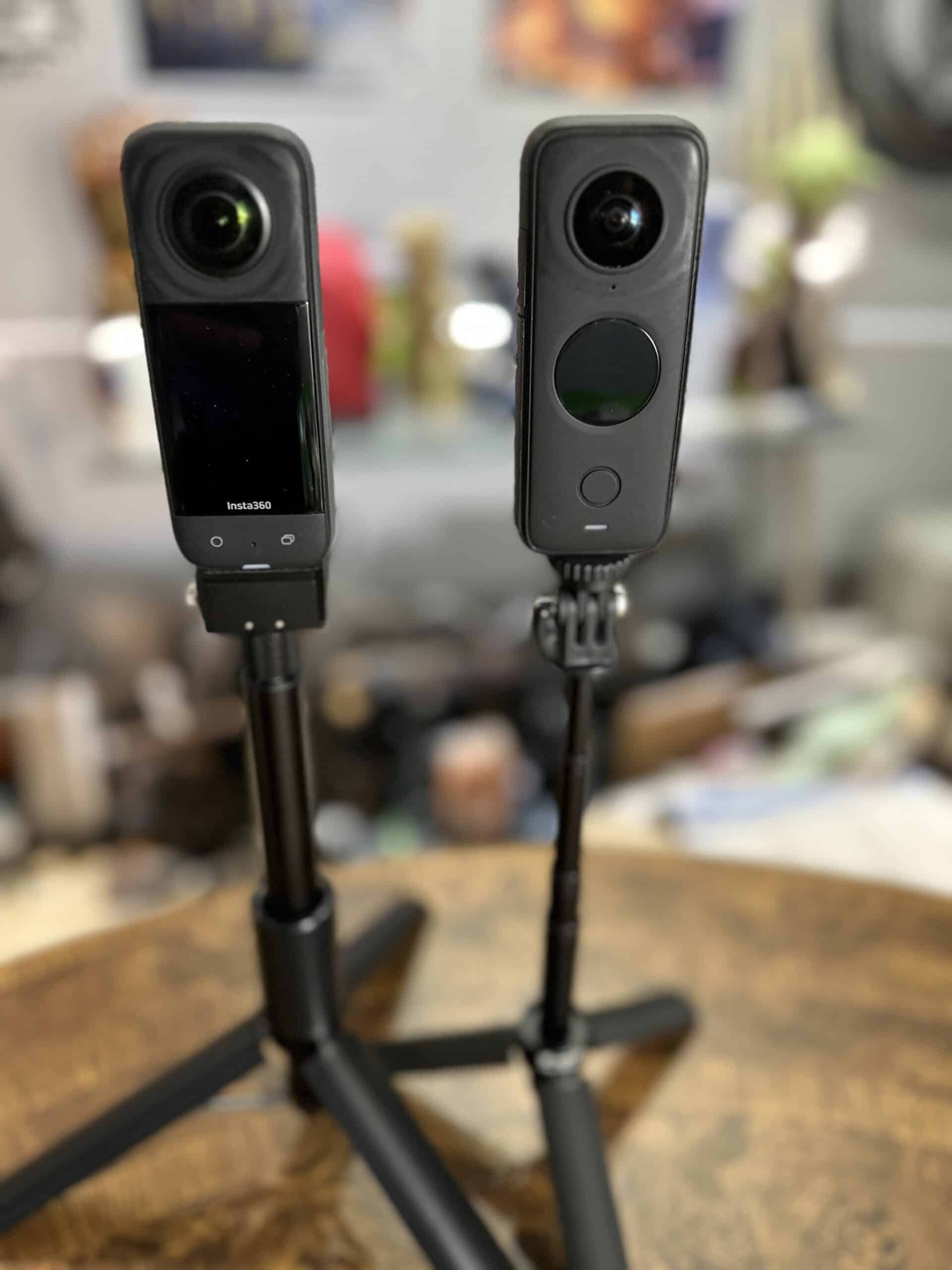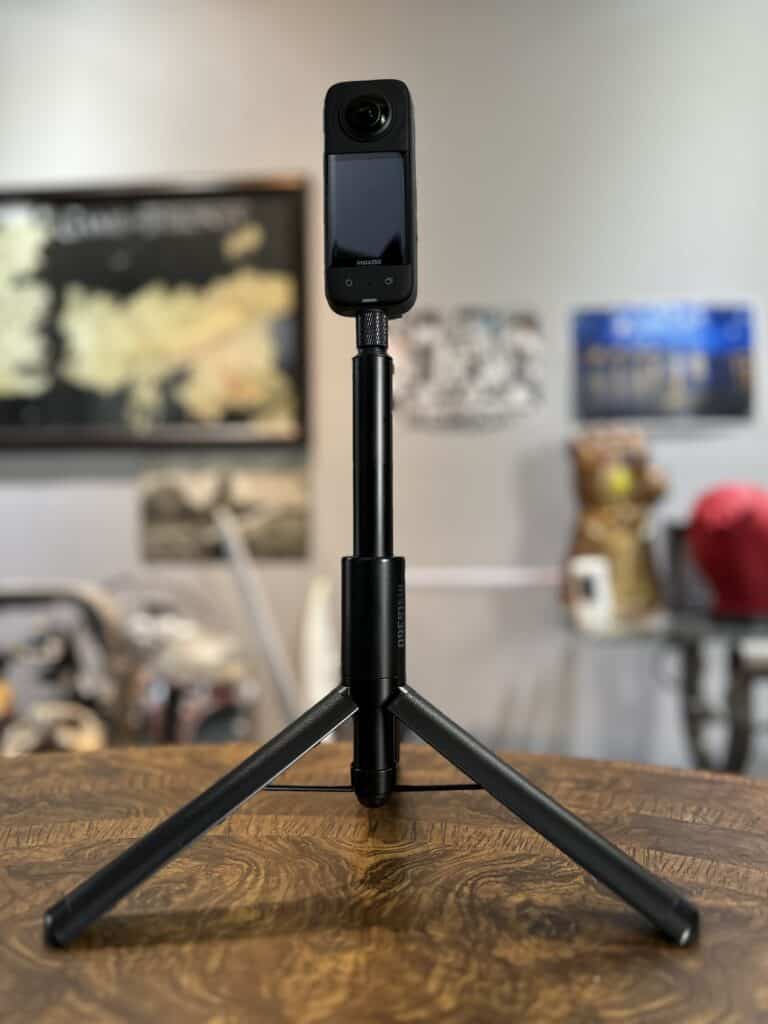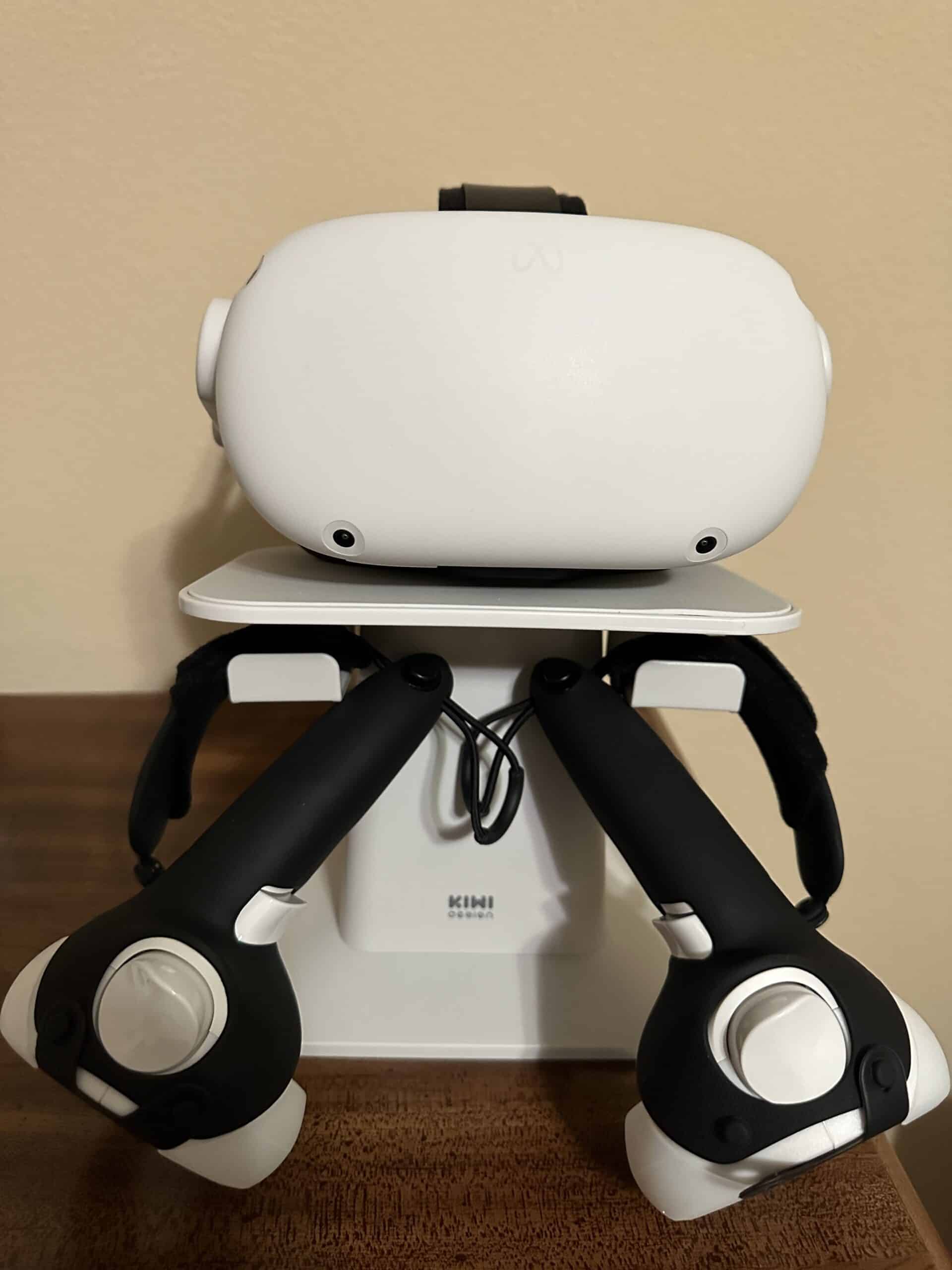Difference between 360 and 180 video? Which one better for you?
In this deep dive into 360 monoscopic vs 180 stereoscopic 3D video, we’ll dissect their differences and explore to pros and cons of each.
I travel the world with my 360 camera and post 360 videos, so I’m very familiar with those.
Here is an example of a 360 VR monoscopic video I shot.
What is a 360 Video
A 360 video is full-circle, all-around view right from where you stand. With a 360 video, you can experience the event from every angle by simply swiveling your head.
The beauty of it is that unlike conventional videos that restrict what’s within their frame, these videos give viewers the power to control their viewing experience.
They are also referred to as spherical videos – because they capture everything around them like a giant sphere.
360 video is what most people think of when they hear VR video or virtual reality.
Here is my article on what’s the difference between a 360 vs VR video?
Photo of 360 camera. My Insta360 X3 and X2.

Diving Into the Immersive Experience
Imagine looking all around at your favorite concert or standing amidst vast landscapes; each detail makes your personal viewing experience richer.
I shoot and post 360 videos on YouTube of my travels around the world.
Here is my article on why I use Insta360 X3 to take 360 videos while travelling.
This isn’t just for fun though, even businesses use them for training purposes, and even home videos for realtors.
The Tech Magic Behind It All
You need cameras equipped with multiple lenses which simultaneously capture different sections of whatever scene is before you.
All those individual images get stitched together using specialized resulting in seamless footage – think one large spherical image wrapped onto itself.
This process ensures smooth transitions and realistic visuals, enhancing VR enabled environments everywhere.
Since each place you look in the scene is one lens, it is considered monoscopic ( flat scene with one lens ) rather than stereoscopic.
180 Video: Half the Sphere
It’s a semi-circular visual experience that immerses viewers in front half of an environment around a camera.
Tech Behind 180 3d Stereoscopic Videos
So how does this work exactly?
With stereoscopic 180 VR, each lens is slightly offset to give the feeling of depth as you do in real life. If you have ever seen a 3D movie at home or in the theater while wearing 3D glasses then you know what I’m talking about.
User Experience: Less Is More with Immersion
The main attraction of the format isn’t just its immersive capabilities but also user comfort. By focusing on only what’s directly in front (half the sphere), it reduces the potential sensory overload caused by having activity happening everywhere at once like in a 360 video.
This also lets the creator guide where the viewer looks, to focus on what’s important.
This also means less likelihood for motion sickness since you don’t have to spin around to see everything like you do with 360.
Exploring the Distinct Worlds of 360 vs 180 Video
While they may seem similar at first glance, there’s a world (or half-world) of difference between them.
A Tale of Two Hemispheres
The main distinguishing factor between these two types lies within their field of view scope. For instance, if we consider our human vision as an example – it covers around 120 degrees horizontally.
Now compare this to both types: while a full-circle 360 coverage allows us to look all around us ; its counterpart 180 only provides visibility for half that area but still is wider that our usual visual field of view so we can still turn out head to get the full 180 field of view.
Key Takeaway:
360 provides a full-circle view akin to standing in the center of a sphere, – perfect for tourism or gaming applications. On the other hand, 180 videos only cover half that area but could be more efficient and enjoyable with more focused field of view for storytelling and focusing attention of viewer.
Perks of Going Full Circle with 360 Video
If you’re into immersive experiences, then 360 video is your go-to.
The great thing about this technology is that you have the power to choose what part of the scene catches your fancy and deserves more attention.
Imagine yourself standing in an architectural wonder like The Colosseum or Taj Mahal.
Monoscopic 360 is what most people think of when they think of a VR video.
A Whole New Level of Engagement
In contrast to traditional flat videos where viewers passively consume content, VR offers interactive engagement. Users actively participate by controlling their view, resulting in potentially improved retention rates as they remember things they interacted with personally.
This makes it particularly useful for educational institutions looking to enhance learning experiences and businesses aiming for effective marketing strategies that resonate with their audience.
Or for travel blogs and YouTube channels, where 360 travel experiences really let you see the area before you go for real. Here is a link to my 360 VR travel videos on YouTube.
Making Your Content Stand Out
With the digital space being so crowded these days, presenting content through innovative mediums like 360 video could be your ticket to stand out from the competition, providing something new and exciting for audiences.
Furthermore, creating high-quality 360 videos require specialized equipment and expertise, adding a layer of professionalism that helps build trust among potential customers who view your content, as well as preventing easy competition from others.
Unpacking the Advantages of 180 Video
While you might think the full panoramic views offered by 360 videos are superior, there’s something unique about 180 videos that can’t be overlooked: focus and 3D.
A More Focused Viewer Experience
In contrast to its spherical counterpart, the beauty of using a half-sphere or 180 video lies in its ability to command undivided attention from viewers to the area the creator wants.
The experience is akin to being in the front row at your favorite theater performance – all eyes on stage with no distractions whatsoever.
Making Production Easier and More Efficient
The production process for half-sphere cameras designed for capturing 180 video, however, simplifies this task significantly when compared to their fully spherical counterparts. Less set design and minimal post-production work make it an attractive choice for creators looking to streamline workflow.
Enhancing User Comfort Levels
With the extensive rotation required for viewing immersive media like 360-degree videos, some users may find it disorienting or even nauseating over extended periods of time. On the contrary, the ease-of-use provided by straightforward left-to-right scanning makes consuming content via 180 degrees far more user-friendly, particularly for those new to virtual reality experiences.
However if the video is in stereoscopic 3D and it is not shot extremely steady, some people cand get nauseated as each eye sees a different scene that doesn’t match up. Some of you may have had this experience watching a 3D movie.
Key Takeaway:
There’s a unique charm to 180 videos that packs quite a punch. Think front-row theater seats – focused and intimate. Add in the ease of production with half-sphere cameras and you’ve got yourself an efficient storytelling tool. And let’s not forget viewer comfort.
Cameras for 360 vs 180 Videos: how they work
These cameras come in two primary flavors: monoscopic 360 and stereoscopic 180 cameras.
Monoscopic 360 Cameras
Current consumer 360 cameras are 360 monoscopic. They capture snapshots from various angles and stitch them together like an intricate puzzle, creating flat but immersive visuals that are perfect for viewing on screens or VR headsets.
However, they lack depth perception, as everything appears equidistant, since each scene is only from one lens.
On the cheaper price point consumer side is the Insta360 X3, GoPro Max, and Ricoh Theta 360 cameras.
Here is my article on picking the GoPro Max vs Insta360 X3 for 360 camera choice.
Higher quality more expensive ones like the Insta360 Pro 2 run $5000+. They have more than 2 lenses and sensors so can get a much higher maximum resolution.

Stereoscopic 180 Cameras
On the other hand, we have stereoscopic cameras, ( 180 3D ) which offer a more dimensional experience by capturing two images simultaneously from slightly different viewpoints. This mimics how our eyes work. When viewed through VR gear or similar devices, these shots deliver a sense of depth that makes it feel as if you could reach out and touch what’s in front of you.
This 3D effect comes into its own in gaming or virtual tours, where the ability to judge distances enhances user immersion significantly.
Some examples of affordable 180 cameras include the Vuze XR, Kandao Qoocam Ego, and Insta360 EVO which really didn’t take off after being released a few years ago for the consumer market.
And of course there are super high end 3D cameras that give a better stereoscopic effect that are used in movies like Avatar, but are not 180.
However for the higher end consumer Canon has come out with the dual fisheye lens attachment for their own cameras. Worth watching the video below to get a good idea of how 180 cameras and 3D work.
Picking Sides: Monoscopic vs Stereoscopic
If you’re looking for eye-catching visuals without much concern about depth perception and you want a full 360 immersive experience, then monoscopic 360 cameras are the right choice.
But when aiming for richer experiences with perceived depths, and want to focus the audience in one area, then 180 Stereoscopic 3D is the way to go.
Key Takeaway:
Decoding the VR camera conundrum, we find monoscopic cameras stitch snapshots from various angles for flat yet immersive visuals. However, they lack depth perception. Stereoscopic cameras offer a more dimensional experience by mimicking human eyesight and adding depth.
How to Watch 360 vs 180 Videos
I watch both 360 videos and 180 3D videos on my Meta Quest 2 headset and I have that article on that topic.
How to watch 180 videos
First, let’s talk about 180-degree videos. This type of video captures footage in a half-circle view, giving you a wide field of vision, but a blacked out hard stop points at 180 degrees all around.
Monoscopic non-3d 180 can be viewed on a phone or PC.
However, to fully enjoy the experience of stereoscopic 3D 180 videos, requiring it to be shot on a 180 cam with 2 lenses facing same direction, you’ll need a virtual reality (VR) headset.
Here’s an article on how to watch VR videos on a VR headset.

3D 180 provides a more immersive experience by making you feel like you’re actually inside the video because you can appreciate the depth and dimension of the content, as if it were right in front of your eyes in real life.
Here is a great 180 3D sterescopic video. If you dont have a VR headset or Google Cardboard device, then you can still watch for just the 180 effect.
How to watch 360 videos
On the other hand, 360-degree videos offer a complete panoramic view of the surroundings.
Unlike stereoscopic 3D 180 videos, you don’t necessarily need a VR headset to watch them, although the VR headset experience is much nicer and immersive.
You can enjoy 360 videos on your smartphone or PC. You to use your device’s gyroscope or mouse to navigate through the video as if you were physically turning your head.
Many platforms and apps support 360 and 180 videos including YouTube and Facebook, but my favorite is YouTube because it has more support and videos library. VR headsets like Meta Quest 2 also have their own dedicated apps for watching.
I watch my 360 travel videos on YouTube VR app on Meta Quest 2.
Google cardboard used to be a nice cheap way to watch 180 and 360 videos, but has lost its appeal as google stopped supporting it a few years ago. Here are ways to watch your 180 and 360 videos.
Unleashing the Power of 360 vs 180 Videos
1. Changing the Game in Gaming
Gaming is no longer confined to facing one direction on your couch; with VR technology like 360-degree videos, you can actually step into the game. You get to see everything around you – behind, above, below – it’s as if you’ve been transported into another world.
2. Revolutionizing Education
No more yawning during history or science class. With VR technology, students can embark on virtual field trips or watch simulations that make learning interactive and fun.
Picturing historical sites in every direction through panoramic visuals transforms dry facts into dynamic exploration adventures.
And those complicated scientific experiments? They become crystal clear with focused 180 demonstrations.
3. Spicing Up Entertainment & Marketing
The entertainment industry is also jumping onto the VR bandwagon by producing innovative films and music concerts using both videography techniques for different perspectives. It’s like being there but without having to leave your home.
360 for looking all around the stadium, or 180 3D for focusing on the stage.
4. Bringing Destinations to Your Doorstep Through Virtual Tours
Travel companies have started offering virtual tours so people can explore destinations from the comfort of their living room sofa. Full sphere walkthroughs allow tourists to navigate places at their own pace while semi-circle 180 views concentrate on specific points such as architectural details.
Here is my article on watching 360 videos before travelling for real.
I use my 360 camera to post 360 videos on YouTube for the full spherical experience, however I’m waiting for a good, affordable 180 camera to come along so I can try my hand at that.
Key Takeaway: 360 and 180 videos are transforming gaming into immersive worlds, making education a thrilling ride, adding spice to entertainment and marketing, and teleporting exotic destinations right onto our living room sofas. Each format has its strengths – while 360-degree videos offer full-blown panoramic experiences and 180 for a focused 3D experience for only what’s in front of you.
Future of 180 and 360 Video
Although 180 video has fallen by the wayside after a surge of interest in 2018, I have a feeling it was because the tech was not quite ready for prime time.
The consumer version probably didn’t have enough resolution, and the 3D probably wasn’t good enough due to tech limitations that probably caused a poor viewing experience and even side effects.
However with the Apple Vision Pro coming, one of its selling points was that it could both film in stereoscopic and well as display 3D. This high end device with a powerful processor and amazing VR screen could be whats bring 180 videos back into the limelight again.
The increase in processor quality in both cameras and headsets will also improve 360 videos as well. Especially if sites like YouTube stop highly compressing 360 videos which is leading to a poor experience for 360 viewers.
The Quest 3 is coming out soon, and this will give a much needed boost in screen quality and processor speed.
Conclusion
What is the difference between 360 and 180 video? Which is better?
Well, after reading the above, now you know the one that’s right for you!
Here are some other related articles on my blog if you want to read more about virtual reality and 360 cameras and videos.
My Gear:
Insta360 X3
Meta Quest 2
Review of Insta360 X3 vs Insta360 RS 360 1 inch edition
Future of 360 video in tourism industry
Link to my category page on Orlando Travel with 360 videos

